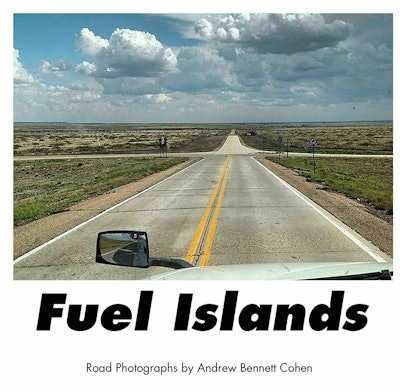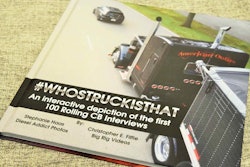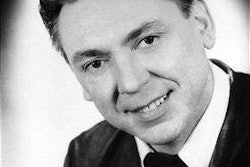Andrew Bennett Cohen spent just upward of a year hauling commercially, and the working environment he experienced as a company driver for two large fleets, and one more a tier down in size from the other two, over the course of that time is ultimately the “book he didn’t want to write” as a result of his brief tour as a CDL driver, he says. The one he did, however, is something of a photographic picaresque of life on the road and captures moments he sees as transcending mere blips in time and place to become something more.
In short, though the photos were originally published instantly (and ephemerally) to his Instagram account, the best among them held artistic qualities now in evidence in the more timeless format of the book.
He’s called it “Fuel Islands,” and its images run the gamut from, in fact, landscapes from the fuel island to telling images like that of three empty chairs around a computer kiosk, presumably from a truck stop — a legend on the wall above the computer exhorts viewers to “Find Your PerfectFitCareer.”
There’s the abstract red-white-and-blue stripe on pavement, a lone Volvo tractor in an otherwise empty parking lot, the rainbow above the two-lane blacktop, a blue pallet laying atop dead weeds as if thrown there from a high place or dropped from the heavens.
 The book is available in 8-inch-by-8-inch hard- and softcover versions, likewise electronic, from $8.99 (for the pdf) on up. Cohen published the collection himself via the Blurb platform.
The book is available in 8-inch-by-8-inch hard- and softcover versions, likewise electronic, from $8.99 (for the pdf) on up. Cohen published the collection himself via the Blurb platform.Readers will notice plenty familiar in these images, shot in places ranging all across the United States, from Cranston, Rhode Island, to Salinas, Calif. But it’s the unfamiliar, ultimately, that marks the best of them. Cohen didn’t find that PerfectFitCareer in trucking, no doubt — his long-haul sojourn followed a career in journalism in and around New York City — but with this book, he’s left a nice record for the rest of us that he was here.

From Cohen’s intro to “Fuel Islands”:
GALLUP, New Mexico: I was wandering around a truck stop, with time to kill before getting back to my truck, when I noticed a stack of crates of different colors. I reached for my phone to take a photo, then changed my mind. A few steps later I recalled an old article in Newsweek magazine (where I once working as a copy editor) about a Southern photographer celebrated for, among other things, an image of trash in the gutter. I turned back and made a photo of the crates. Minutes later, I photographed a picnic table. I allowed myself to take similar photos the next day, and the next, until I had this book.
I knew my photos weren’t just snapshots — souvenirs of a place — but I didn’t know what they were. I realized that some of my earlier photos, taken during trucking school in Missouri, were similarly non-snapshots. I began reading up on photographers who had “hit the road” before me, some of whom I’d heard of: Robert Frank, Henri Cartier-Bresson, William Eggleston (whom I’d read about in Newsweek years before).
I got into truck driving in 2015 after being unable to find a job in New York journalism, which I’d worked in for most of the previous 20 years. As a driver, I felt the sting of lowered status (drivers are seldom treated with much respect) and hardship, but driving a big-rig back and forth across America also had its moments of elation: a stunning sunset over Ohio, a snow- blanketed South Dakota. Despite the 12-hour shifts, with most of my off-duty time spent in the rear bunk of a tractor cab, there was a certain elevating mystery that accompanied the alienation of a life measured by the distances between fuel stops.
Given my background, many suggested I write a book about my trucking days. I didn’t want to. I’d lived it once. I didn’t want to relive it. When I had the chance to leave that world, I did. But I did want to try to capture some of the mystery of that life, and that is why I made this book. —Andrew Bennett Cohen










